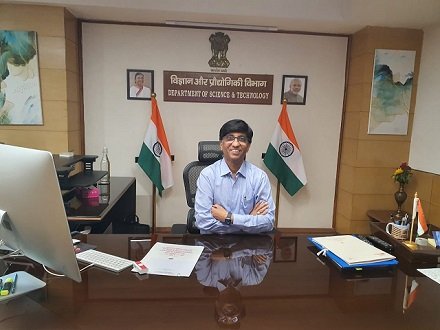
At the 20th FICCI Higher Education Summit 2025, Shri Abhay Karandikar, Secretary, Department of Science and Technology (DST), outlined how India is transforming its research ecosystem, energising young entrepreneurs, and positioning itself as a global leader in science, technology, and innovation.
Transforming India’s Innovation Landscape
Over the last decade, India’s journey in research and innovation has been nothing short of remarkable. “On the Global Innovation Index, India has jumped from 81st in 2014 to 38th this year,” Shri Karandikar noted with pride. “We have also risen from 7th to 3rd globally in scientific and engineering publications and now rank third in the world in the number of PhDs in science and engineering.”
The momentum extends beyond academia. India today boasts the third-largest startup ecosystem in the world, with over 170,000 startups and 118 unicorns—a quantum leap from just a dozen a decade ago. Shri Karandikar emphasised, “These are not just statistics, but signals of transformation — enabled by government policy, but driven also by a younger generation of entrepreneurs.”
To support this vibrant ecosystem, the government, through DST and other bodies, has strengthened the backbone of innovation. Nearly 150 technology incubators are operational across academic institutions, contributing to a nationwide network of over 1,200 incubators and accelerators.
The National Research Foundation: Democratising Research Excellence
Central to this new phase of transformation is the Anusandhan National Research Foundation (ANRF) — a bold step envisioned under the National Education Policy 2020 to make research both accessible and impactful. “Until recently,” he explained, “research productivity was highly concentrated. Out of 1,100 universities, just 18 were very productive, 45 moderately so, while over 600 contributed almost no research output.”
To correct this imbalance, the ANRF has introduced the Hub-and-Spoke Network, pairing top-tier institutions with state universities and colleges. “Seven such networks have already been established, benefiting 49 state universities, and we plan to scale this up to 200 or even 300 in the coming years,” Shri Karandikar shared.
He also highlighted mission-mode programs focusing on critical sectors such as electric vehicles, advanced materials, photonics, medical technologies, and artificial intelligence — a blueprint designed to push India’s research beyond boundaries and link it to national priorities.
Advancing Frontier Technologies
DST’s sectoral missions reflect India’s aspiration to lead in frontier technologies. The Quantum Technologies Mission, encompassing 43 institutions and 250 researchers, seeks to establish global competitiveness in quantum computing, communications, and sensing.
On artificial intelligence, India’s ambitions are equally bold. “We now have more than 10,000 GPUs in our national AI infrastructure, and plans are underway to expand further,” he said. “DST is promoting Indian-language large language models through university and startup collaborations.”
The Bio-E3 Policy aims to boost the country’s bioeconomy — already valued at USD 150 billion — with a goal to double it by 2030. “From bio-based chemicals to lab-grown food and biodegradable materials, India’s bioeconomy will be a pillar of sustainable growth,” he added.
In the health sector, DST’s collaboration with ICMR, the Department of Biotechnology, and AYUSH has birthed initiatives such as MedTech Mitra and programs in gene therapy and robotics in surgery. “ANRF will also fund medical devices research in universities,” Shri Karandikar revealed, underscoring the government’s integrated approach to innovation-led healthcare.
Knowledge for All: One Nation, One Subscription
In a major step toward democratising knowledge, the One Nation One Subscription initiative now provides nationwide access to premier international research journals. “Nearly 20 million students, researchers, and faculty across publicly funded institutions can access the world’s leading academic resources,” Shri Karandikar shared. The DST also plans to extend this facility to private universities, ensuring that access to knowledge is not limited by institutional boundaries.
The Crucial Role of Universities
Reiterating the centrality of universities in India’s research mission, Shri Karandikar urged higher education institutions to take the lead in collaboration, commercialisation, and capacity building.
“Our universities must engage deeply — across India and internationally — to pool infrastructure and expertise,” he said. “They must strengthen the pathway from lab to market, encourage spin-offs, and align research priorities with national missions in AI, quantum, green hydrogen, and semiconductors.”
For India to truly emerge as a global innovation hub, he emphasised, universities must not only produce knowledge but also nurture the next generation of scientific talent through robust PhD and post-doctoral programs.
The ₹1,00,000 Crore RDI Fund: A Game Changer
Looking ahead, Shri Karandikar highlighted one of the government’s most ambitious steps — the Research, Development & Innovation (RDI) Fund, a sovereign fund of ₹1,00,000 crore. “This fund is designed to encourage the private sector to invest in deep tech R&D and support projects at higher technology readiness levels,” he explained. “It will help bridge the ‘valley of death’ between discovery and commercialisation and catalyse industry-led innovation.”
The fund, to be operationalised in the coming months, marks a decisive shift in India’s innovation financing, bridging academia, startups, and industry through a shared commitment to technological advancement.
Toward a Developed, Future-Ready India
“Our goal is to build a world-class science and technology ecosystem, driven by strategic investment, collaboration, and globally competitive research,” he said.
“Universities, as both creators of knowledge and trainers of talent, will be central to this journey. It is not just about publications or patents, but about converting research into meaningful outcomes — technologies, companies, and solutions to societal challenges.”
In a tone that captured the spirit of ‘Viksit Bharat 2047’, he concluded, “With sustained effort, institutional backing, and the energy of academia and industry combined, we can ensure that not only do we break records, but also build resilience, prosperity, and global leadership.”
Leave a Reply